Alligators and crocodiles are similar to each other in size, behavior, and appearance. It can sometimes be quite difficult to tell them apart. This is especially true in the southern United States where both species live.
If a crocodilian has you confused, then fear not! There are many subtle but significant differences between the two species. They can be identified by their snout shape, size and color. Typically, alligators are dark green or black with u-shaped snouts. Crocodiles are light green, brown or light grey and have v-shaped snouts as well as visible bottom teeth.
Still not sure which one you’re looking at? This guide will teach you how to spot the difference between alligators and crocodiles!
Differences Between Alligators And Crocodiles
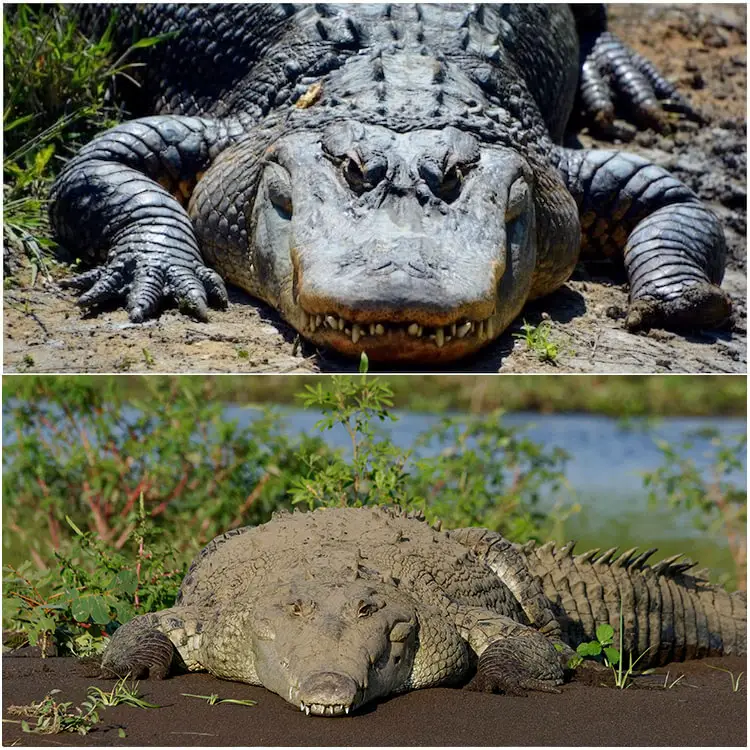
When trying to compare an alligator vs crocodile, your location is the first thing you should think about.
If you are in the United States, you will not see a crocodile unless you are at the southern tip of Florida. Any other type of crocodilian in any other state is certainly an alligator. American gators can be found anywhere from east Texas to North Carolina.
You can also take a look at the environment. Crocodiles are able to swim in open streams due to their ability to excrete excess salt with the help of their lingual salt glands. Most alligators tend to stay closer to the shore, remaining in swamp lands and lakes.
Next you will want to take a good look at their body color. If it is light green, brown, or light grey, you have probably found a Crocodile. In the United States most crocodiles are almost always slate grey. If it has dark green or black scales, you have likely got a gator. The American alligator’s darker colors allow it to blend in better with the mud.
Now you should consider the size.
An adult crocodile is on average three feet longer than alligators. In the United States, this is no exception. The American croc can reach a length of about 17 feet, while the maximum length for an American alligator is 13 to 14 feet.
Finally, you should try and look at the shape of the snout and the jaw. If you can get a good look, this is the easiest way to tell the two apart. Of course, you do not want to get too close to one! But even from a distance, the shape of the snout will tell you if you have got a gator or a croc.
Crocodiles always have a triangular snout in the shape of the letter V. This shape is the same no matter the species. Alligators have a rounded snout in the shape of a U. It is much wider and broader than a crocodile’s
If you do get a look at the teeth, you will notice that a crocodile has five visible bottom teeth. An alligator will only show the teeth on top.
| Alligator | Crocodile | |
|---|---|---|
| Size | 14 feet | 17 feet |
| Weight | 500 to 1000 pounds | 800 to 1000+ pounds |
| Color | Dark Green or Black | Light Green, Brown or Light Grey |
| Snout | Rounded U shape | Triangular V shape |
| Teeth | Only shows top teeth | Five visible bottom teeth |
| Sates | Most southeast states (i.e. from east Texas to North Carolina) | Florida |
In the United States, both alligators and crocodiles tend to be shy and timid. This is similar to most reptile and lizard species. However, you should always keep a safe distance from them.
1. Alligators Are Dark Green Or Black
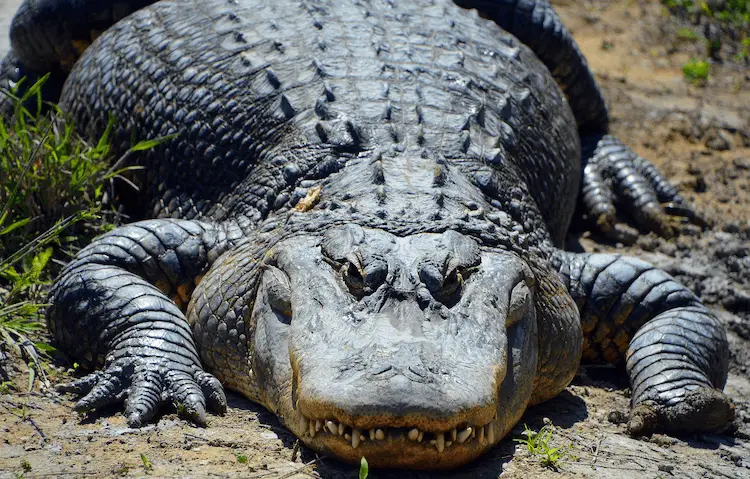
Color is one of the easiest ways to tell the difference between crocodiles and alligators.
Most crocodiles come in shades of green, grey, brown, or black. They usually have a mottled or speckled pattern which helps them to blend in with algae and substrate.
American crocodiles are normally slate grey and have a white to yellow underside. This dark and light coloration is called countershading. It allows them to blend into the water while on the hunt.
Other species of crocodiles come in different shades, depending on the colors of their environments.
For example, the saltwater crocodile is the best example of the typical ‘green crocodile.’ Its dark green scales help it blend in with algae. The Nile crocodile comes in deep green and brown speckles that match the substrate of the Nile River.
In contrast, Alligators usually come in dark green to black.
The American alligator is a shiny dark green that can look almost black in certain lights. It is much darker color than a crocodile.
Just like a crocodile, their colors will vary based upon their habitat.
Crocodiles tend to live in open water areas with much more algae. Because of this they are usually going to come in greener shades to match. Alligators tend to stay near the banks of rivers and lakes. Their colors are designed to blend in with the mud and the substrate.
2. Crocodiles Are Bigger Than Alligators
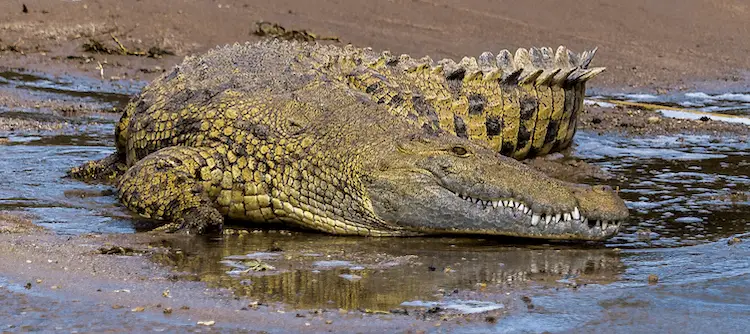
Most crocodiles are larger than alligators. The saltwater crocodile is the largest and can reach lengths of up to 23 feet. NIle crocodiles are among the “smallest” crocodiles at just 16 feet long and around 500 pounds heavy.
The American crocodile reaches a maximum length of 20 feet, but is usually between 15 and 17 feet. It weighs anywhere from 800 to just over 1000 pounds.
American alligators are smaller than crocodiles.
Male alligators reach an average length of between 12 and 13 feet and can weigh up to 1000 pounds. Females are between 8 and 10 feet and weigh in at 500 to 700 pounds.
An American croc is larger than an alligator by about 4 to 6 feet on average. However, it can be difficult to eyeball the size of an animal when seen from a distance. For this reason size is one of the hardest ways to identify each species.
3. Crocodiles Have V-Shaped Snouts
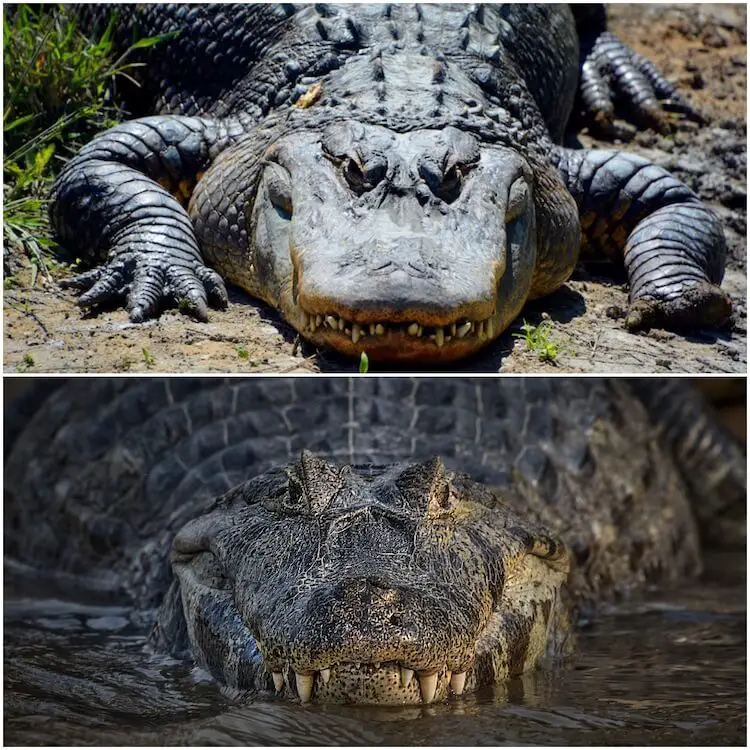
When you first see a crocodilian, the snout should be the first thing you look at if you want to know what it is. Snout and jaw shape are the easiest way to tell the difference between alligators and crocodiles.
Alligators have large, broad snouts that are shaped like the letter U.
Every crocodile species have a pointed, V-shaped snout.
A crocodile’s snout may be very wide or very narrow, but it will always have the same pointed shape. Their jaws also close from the top-down, rather than from the bottom-up.
This overbite and underbite means a croc’s jaw exposes both its top and bottom teeth, in a sort of ‘jagged’ formation. If you look closely, you will see five of its bottom teeth.
Unlike a crocodile, an alligator’s jaw closes downwards and you can only see their top teeth. Notches in their bottom jaw hide the bottom teeth when their mouth is shut.
Of course, you do not want to get close enough to a croc or a gator to be able to see their teeth!
4. Crocs Have A More Powerful Bite!
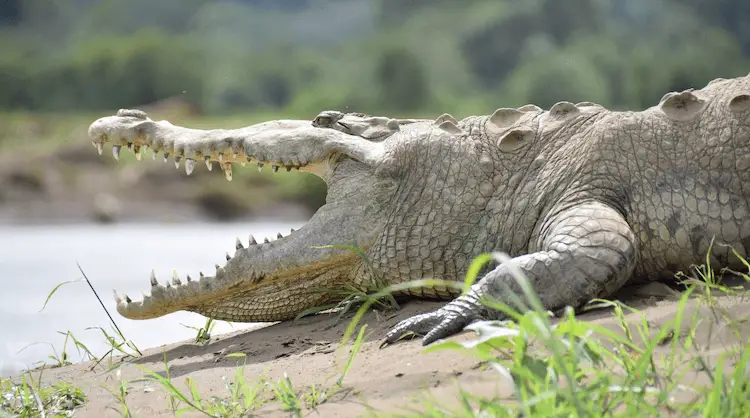
Crocodiles’ teeth are sharp and pointed because they are designed for tearing. Crocs have an incredible bite strength of about 3700 psi.
The alligator’s jaw is meant for crushing prey, instead of tearing. This is why their teeth are cone shaped rather than pointed. Their bite strength is about 2500 psi. While considerably less powerful than a crocodile, alligators kill turtles by crushing them with their mighty lower jaw.
5. Alligators Have Tiny Black Spots
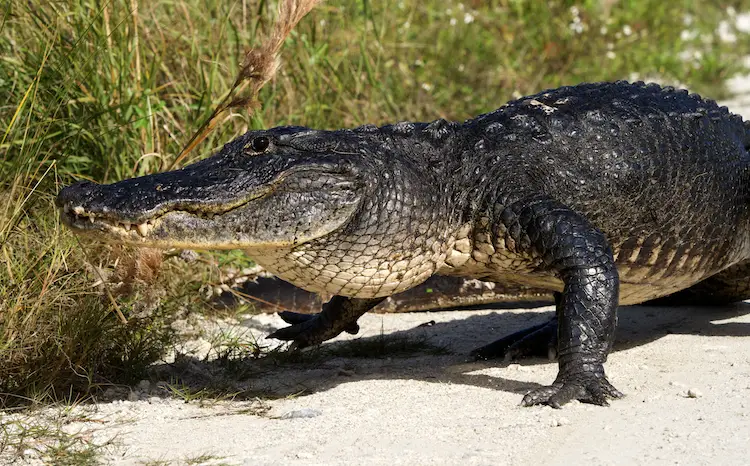
Crocodiles and alligators both have dome pressure receptors on their skin. These receptors allow them to regulate water pressure when swimming and detect ripples in the water.
Alligator’s dome pressure receptors are visible as tiny black spots near their jaw.
The dome pressure receptors of a crocodile are translucent and scattered all over their body. This is one of the reasons they swim better in open water when compared to gators.
Crocodiles also have salt glands on their tongues, which allow them to osmoregulate in high salinity areas. Alligators do not have any salt glands.
6. Gators Can Live In Colder States
Most species of crocodile live in marshes and wetlands alongside rivers and lakes. Sometimes they may venture out into fast-moving streams, rivers and channels because they are able to live in salty waters.
Alligators normally live closer to the shore. Their natural habitat is mostly swamp lands, lakes and low flow areas of rivers. They are not able to live in saline waters.
Temperature is the reason why the American alligator lives in more states than a crocodile.
Both species are cold blooded, but crocodiles need a higher temperature to survive. You can find them in temperature ranges from 85 to 93°F. Alligators can survive in temperatures as low as 79°F before becoming dormant.
Alligators are more resistant to lower temperatures; they are able to live in colder areas.
The American alligator’s northernmost range reaches North Carolina vs. the American crocodile’s northernmost range of the southern tip of Florida. If you are in the United States and not in south Florida, it is probably an alligator.
Another way to tell whether you’re facing an alligator vs crocodile, figure out whether you’re near freshwater or salty waters. Alligators live in and nearby freshwater habitats, whereas crocodiles live in or nearby brackish water or seawater.
7. Crocodiles Are Slightly Older Than Alligators
Crocodiles can be traced back from around 70 million years ago to the late Cretaceous period. But, their ancestry goes back even farther than that. The animals that would later become crocodiles can be traced back to the Jurassic period. These aquatic crocodiles are known as ‘Thalattosuchia’ and lived over 200 million years ago.
The first land Crocodile is considered to be the Sarcosuchus. It appeared in fossil records about 110 million years ago and was over 40 feet long.
Alligators as we know them today can also be traced back to the late Cretaceous period, but their ancestors are not as old as Crocodile’s ancestors. Early alligators include Deinosuchus and Mourasuchus. These species are both from the late Cretaceous period and not the Jurassic period.
If we go by fossil records, Crocodiles are slightly older than alligators.
8. There Are Fewer Alligator Species
Both crocodiles and alligators both belong to the order Crocodilia. This order also includes caimans and gharials. Alligators and crocodiles belong to the same order, but they do not belong to the same family.
Crocodiles belong to the family Crocodylidae, which includes 13 different species. These species can be found in the United States, Australia, India, Africa and Southeast Asia. Interestingly the red eyed crocodile is a species of skink and not croc.
Alligators belong to the family Alligatoridae. This family includes two species of alligators and five species of caimans. The title of the biggest alligator species belongs to the black caiman.
You can find two species of crocodilians in the United States:
- American alligator (Alligator mississipiensis)
- American crocodile (Crocodylus acutus)
9. Crocodiles Are More Aggressive
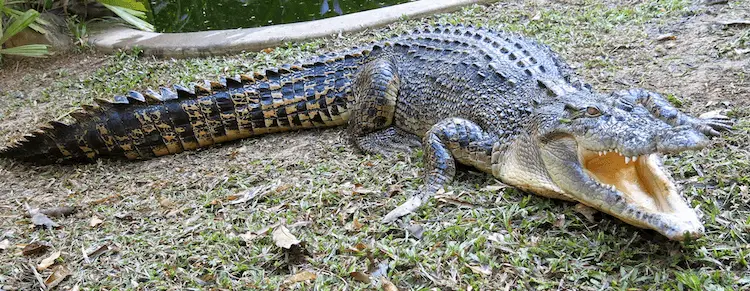
Crocodiles should never be approached or disturbed.
Larger crocodiles such as the Nile and Saltie are known for their attacks on humans. Crocs are opportunistic predators that will go after anything that moves. A hungry one will not hesitate to go after a human that gets too close.
There are several hundred reported crocodile attacks on humans every year. This is more than the number of annual shark attacks. Most of these attacks happen in Australia where the Saltie lives, but the Nile crocodile is very dangerous too.
American crocs are shy compared to other species. They are more likely to shy away from humans unless they are provoked.
Alligators make up less than six percent of all reported crocodilian attacks. An alligator is often more afraid of you than you are of it. They will only attack when disturbed or when it is protecting its eggs or young.
Alligators and Crocodiles Frequently Asked Questions
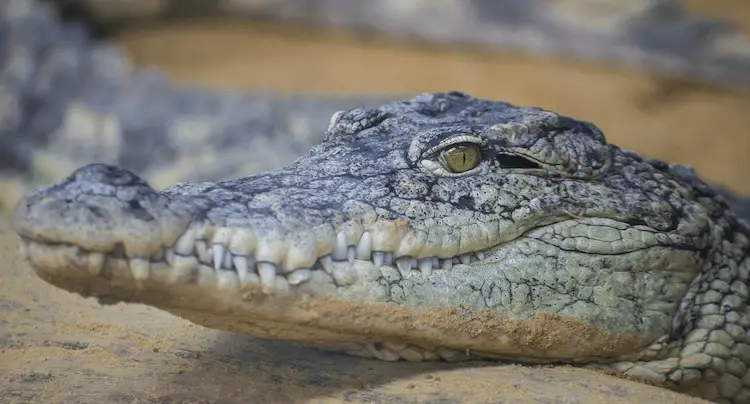
Alligator vs Crocodile Fight
One of the most common questions is who would win in a fight between an alligator and a crocodile? In a hypothetical fight, the crocodile wins nearly 100% of the time. It has a bite strength over 3,500 psi and is likely to attack, even when unprovoked.
In comparison, the American alligator’s bite strength is only about 2,900 psi and they are also smaller in both size and weight.
Can You See a Crocodile’s Teeth?
Another common way for distinguishing alligator vs crocodile is by its teeth. Generally, crococildes keep their teeth visible even when their mouths are shut, most notably the large fourth tooth. So, if you can see the upper teeth or lower teeth on a large reptile, run for your life.
Alligators are slightly different. An alligator’s upper jaw is slightly wider than its lower jaw. As such, when an alligator shuts its mouth, its lower teeth will be hidden behind the upper jaw, whose teeth are in full display.
Can Alligators Live with Crocodiles?
The southernmost tip of Florida is the only place in the United States where you can see crocodiles and alligators together. But, even in South Miami, they do not live in the same habitat.
You can find alligators in the swamps and marshes along the banks of lakes and rivers.
Crocodiles venture out into open water, fast-moving streams, rivers and channels where the river meets the sea. Saltwater crocs live in dark brackish water or in the open sea, where alligators are not found.
Is An Alligator Faster Than A Crocodile?
Alligators and crocodiles may look lazy while they are basking in the sun, but both can easily outrun a human. Speed is one area where gators have an advantage. Alligators are much faster.
On land, an alligator can hit speeds of up to 30 miles per hour! Crocodiles can only reach about 20 miles per hour over a very short distance.
In the water, an the speed of an alligator is slowed to about 25 miles per hour. A croc’s speed is also slowed to about 18 miles per hour.
Due to their webbed feet, crocodiles can accelerate at high speeds and make sharp turns effortlessly.
How Do Both Alligators and Crocodiles Bite?
A common misconception is that alligators and crocodiles bite by moving their upper jaw. In reality, their bite is similar to humans in that the lower jaw moves up while the top row of teeth remains in place.
Do Nile Crocodiles Hunt Humans?
Yes, they do. In fact, there are 2 crocodile species that are known to attack humans: saltwater crocodiles and Nile crocodiles. With a bite power of over 3,700 pounds per square inch, you should attempt to flee if you ever run into a crocodile.
Alligators, on the other hand, rarely attack humans, though the numbers are steadily increasing. On average, there are only 3 attacks per year in Flordia. Many alligator species are instinctively afraid of humans and will not attack unless provoked.
Can You Keep Wild Alligators and Crocodiles as Pets?
Many places in the US prohibit keeping exotic animals as pets. Both alligators and crocodiles fall into this category, so before you decide to adopt either one, make sure you’re not breaking any lays.
However, nobody wins in the alligator vs crocodile pet challenge. While it’s theoretically possible to tame a crocodilian, a single bit and spin (known as the “Death Roll”) can easily rip your finger or limb off. If crocodiles win in fights against alligators, humans stand no chance.
That said, if you feel brave enough, you might want to see whether or not you have the legal clearance to adopt a saltwater crocodile. If you live in the Land Down Under, you may be happy to learn that you can keep Australian Saltwater Crocodiles as pets!
As a pro tip, make sure you know about cleaning alligator pools safely, as well as keep curious creatures (like pet dogs) away from your alligator at all times.
Are There Crocodiles in Central America?
Yes, there are. Central America is home to the Morelet’s crocodile and the American crocodile, as well as the spectacled caiman. The next time you plan a trip to Mexico, the Caribbean, Cuba, or Costa Rica, keep your eyes peeled for large reptiles with v-shaped snouts and a large fourth tooth!
Summary
You should now be able to tell the difference between an alligator vs crocodile. The main thing to remember is that alligators and crocodiles are different species. They can be identified by their snout shape, size and color.
Alligators are dark green or black, have u-shaped snouts, tiny black spots and are smaller than crocs.
Crocodiles are bigger, have v-shaped snouts and are more aggressive. They also have visible bottom teeth and are light green, brown or light grey.
Both gators and crocs in the United States are more afraid of you than you are of them.
In the state of Florida, these apex predators are just another part of the native wildlife. The best thing you can do is to show them respect and always keep a safe distance.

Nice info. Thanks.
You’re welcome
Really interesting article
I was wondering what the biological relationship was between the two species. Do they have a common ancestor or is it one of those ‘convergent evolution’ things?
I didn’t know before reading this that there were any crocodiles in the US.
Looks like the chart in the article about comparing crocodiles vs. alligators has mixed up the description of the difference in their teeth.
The description of the alligator teeth is correct, their lower teeth are not visible when their mouths are shut. This means only their top teeth are visible as stated in the chart. With crocodiles they usually have both top and bottom teeth visible when their mouths are shut so perhaps the description of “five visible bottom teeth” is not entirely correct. Perhaps this description has come from the fact that there is usually a large fourth tooth in the bottom jaw that is visible with crocodiles.
The reason for the differences in tooth visibility is the size of the crocodile’s jaws. Crocodiles have the same size jaws hence their teeth stick out. With Alligators their bottom jaw is slightly smaller than the top jaw so it fits in underneath only leaving the top teeth visible. Interestingly with alligators and crocodiles, they have 80 teeth in their mouth at a time and these get replaced as they lose them so they can go through a lot of teeth in their lifetime.
Yes, but your pictures show the opposite. The gator shows top and bottom teeth visible, and jaggedly shaped alignment at that (which you mentioned in the croc description), while the croc shows only top teeth.
As suggested by another user, this has to do with the front view of the two species in those pictures. When viewed from the front, the relationship you mention is inverted, so that a crocodile’s front teeth on its lower jaw are tucked behind the upper jaw, and only its upper teeth are visible. On the contrary, when viewed from the side, a crocodile shows both lines of teeth, since it doesn’t have an upper jaw wider than its lower one, as is the case for the alligator.
The problem is with the front-on photos: When viewed FROM THE SIDE, a crocodile has visible teeth pointing both up and down, and an alligator has teeth pointing down only. When viewed from the front, it’s the opposite: the crocodile’s bottom jaw is tucked in and the alligator’s is exposed.
Yes this is spot on!
Do you know why Australia crocs are way more aggressive? Even those crocs don’t like criminals.
Wouldn’t it be nice if they did,
and specialized to eat criminals.
I would then have no problems
swimming in North Australia and in the ocean
Love this list, it’s full of great trivia!
As a practical reference, though, it’s hilarious! Let me sum up:
* Gators are dark green or black. Crocs CAN be dark green or black among other colors.
* Crocs are bigger. So if you see two crocs at the same time and one is smaller, the smaller one might be a gator!
* Crocs have a pronounced V shape to the front of their mouths. Gator mouths are straight across in the front and have small black spots near their mouth. So to tell if the above smaller one is a gator or a croc, just approach it and look closely at its mouth!
* Crocs bite harder. So if you determine that the above is a gator, once both of them attack you (perhaps because you got really close to them to see if it has a straight or V shaped snout), you can can confirm by how hard it’s biting you!
* If it attacks you, it’s probably a croc, not a gator! But still *might* be a gator who was provoked or cornered (perhaps by someone trying to look closely at it’s mouth).
Your comment is not as hilarious as you might thinlk.
Nice article.Thanks
Wow did not know that crocs were bigger than gaters
Thanks for the information, nice article.
One question though…
Why do people call them “Crocs”, instead of “Diles”?
The first documented use of the word seems to be from 1884, and we can only guess it was used because it sounds way more rock ‘n roll than Diles!
What happened to the alligators front foot? 💔
Impossible to say, but males are known to cause each other injuries when competing for mates
You are the VERY 1st Person that has ever explained this in a way that is not just easy to understand, but I will Definitely be able to remember it! Thank you so much for sharing our knowledge in a way that a Chicago Gal could actually get I. You’re Awesome!
This was a well written synopsis of what information I was seeking. I now know Crocs have salt glands, and can’t survive in a cold habitat. Excellent work
Wonderful article! I appreciate the chart and pictures filtered throughout as well! This information helped me understand the differences in a simple and concise way.
Glad you found this informative!
hi Theere, btw the first picture of the face-on “croc” is actually an alligator!!!!!!.
It is a Black or Spectacled Caiman.
How do I know? because I am one too! haha.
But seriously
1. It has an overbite.
2. There are 2 black strips on the lower jaw!!
3. The Triangular popping up close together eyes are that of a caiman. (Kind of like a frog)
4. Overall the “appearance” is that of a cainman, but that’s hard to explain unless you have traveled a lot in the amazon like I have.
Most people think Caiman are small and that “croc” you show looks really big and nasty.
But check out the Black Caiman. It is the BIGGEST ALLIGATOR (although some reports of bigger American alligators exist, so it’s a toss up…depending on source. Anyway they are big.
Thanks, we have updated the picture
This is very helpful information. Thank you!!
‘The main thing to remember is that alligators and crocodiles are different species.’
I think the main thing to remember is that Alligators can run 30mph.